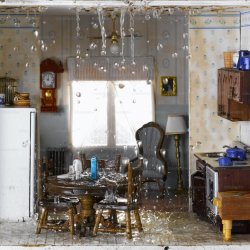5 Tips for Improving Your Home’s Indoor Air Quality
When you start to think about air quality, it’s usually when you’re driving through a city and you spy the layer of smog, or rolling past a factory in the countryside that fills the air with the type of stench you never want to experience. But pollution doesn’t just impact the air quality outside. In fact, the air inside your home might actually be more polluted than what you see when you’re out and about. There are all sorts of pollutants that come from your home’s construction, including formaldehyde, the fire retardants inside your walls, lead particles in common dust and even chemical residue left over from cleaning products. These pollutants come into your home from a wide range of places, but once inside they tend to hang around. Here are five tips to help you improve your home’s indoor air quality.
First of all, try to keep your floors as clean as possible. If you have carpeting, this is doubly important. All sorts of allergens and toxic chemicals can collect in the fibers of a carpet or a rug, and they’ll hang around for years. Your best bet is to pick up a vacuum that comes with a built-in HEPA filter. That filter will attack the lead, allergens, dust and pollen hanging out in those fibers and greatly reduce the concentration. Make sure you keep your vacuum running at peak condition, and use it at least twice a week. Don’t forget to hit the furniture as well, and lay floor mats at all of the entrances, so you don’t track in anything new.
Next, consider the humidity in your home. The more moist the air, the greater the concentration of mold and dust mites you’ll be dealing with. The healthy range is from 30% up to 50% humidity. To maintain those levels, you’ll probably need a dehumidifier during the winter and either a humidifier or a quality air conditioner during the hotter months of the year. You can also make a difference by running an exhaust fan when using the kitchen, and to make sure you’ve got a healthy seal on all plumbing fixtures.
One of the scariest pollutants you might be exposed to in your home is radon. This material could be in the air regardless of the age of your home, and since it is both odorless and colorless you would never know. Have the grounds around your home tested, which you can handle yourself simply and inexpensively. And consider skipping granite countertops, which are known to emit some amount of radon.
That’s a scary situation, but it’s not nearly as significant as the pollutants you put in the air yourself by smoking cigarettes. The smoke from cigarettes includes over 4,000 distinct chemicals, and many of them have been shown to cause cancer. Yet the worst effects may be from secondhand smoke exposure. This is especially serious if there are children in the house. Secondhand smoke may cause a range of maladies in children, including asthma, respiratory and ear infections and sudden infant death syndrome. You should certainly try to quit, but if you’re unwilling to do that, definitely keep the cigarette smoking outdoors.
Finally, look for natural ways to keep the air smelling fresh. Cleaning products with a false scent may make you think the air is clean, but it’s actually the reverse. Air fresheners, fabric softeners and laundry detergents all release chemicals in the air that are dangerous for your system. That’s why Mitsubishi ductless dealers look for ways to circulate air for cleanliness, instead of scenting it with manmade products. Crack the windows and let the air move, and choose products that are fragrance-free. You may miss that piney scent, but the air you breathe every day will be much better for you.
More to Read:
Previous Posts:




